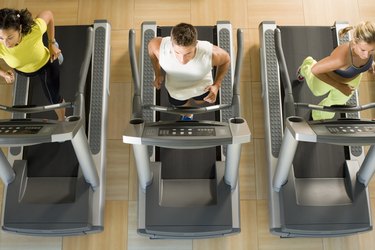
The treadmill and the stair stepper are both long-time cardio favorites at the gym. Both are great ways to elevate the heart rate, burn calories and improve cardiovascular endurance. Examining the similarities and differences between them, as well as the benefits and disadvantages of each, can help you decide whether to incorporate each into your workout routine.
Function
Video of the Day
The treadmill works by allowing a person to walk or run in place on a moving belt that theoretically mimics natural walking or running on the ground. Most have an incline feature that allows the user to create the effect of walking or running uphill. On a typical stair stepper, the user stands on two platforms supported by a given level of resistance and must lift alternating feet, as if walking up a set of stairs, to keep up with the machine. Some stair steppers, often called step mills, have a folding belt that folds out into a small flight of stairs as they circulate through the machines, somewhat like a treadmill, which creates a genuine stair-stepping effect.
Video of the Day
Muscle Activation
Both the treadmill and stair stepper work the major muscle groups of the lower body, including the quadriceps, hamstrings and gluteals. The stair stepper generally places greater resistance on the quadriceps and gluteals than the treadmill. This can result in stronger and more toned glutes and thighs, but may also cause these muscles to increase in size. Depending on your goals, this may or may not be desirable.
Calorie Burn
A 1996 study published in the "Journal of the American Medical Association" compared the energy expenditure for various indoor exercise equipment at a given level of perceived exertion. The study found that for the same intensity level as perceived by the exerciser, the treadmill burns more calories than the stair stepper. Therefore, if your goal is to burn as many calories as you can before feeling exhausted, the treadmill is the better alternative.
Treadmill Benefits
The treadmill, in addition to providing the highest calorie burn for the lowest perceived exertion, allows a high degree of variability in your workout. You can adjust speed, switch from walking to running, and adjust incline, which allows many types of workouts and accommodates a broad range of fitness levels. The stair stepper offers less variability in speed and resistance. Beginning exercisers often cannot spend much time on the stair stepper before exhaustion sets in. The treadmill makes it harder to "cheat" the exercise; stair steppers have hand rails, and exercisers tend to lean on them or support much of their body weight with their arms.
Stair Stepper Benefits
The stair stepper is better than the treadmill if your goal is to build muscle in your legs and glutes. This strengthening effect also makes the stair stepper a very useful cross-training tool, even for loyal treadmill users. The stair stepper is also a lower-impact alternative to running, which can make it useful for those dealing with leg injuries. If you have knee problems, however, the stair stepper should be used with caution. Allowing the knee to press forward over the toes as you step or inadequately activating your glutes can place additional stress on the knees.
Warnings
Consult your physician before beginning any weight loss, diet or exercise program, and stop doing an activity if you experience pain. Exercise is most effective when it is part of a healthy lifestyle that includes good nutrition. Make sure to also take time to stretch at the end of your workouts to prevent overuse injuries.